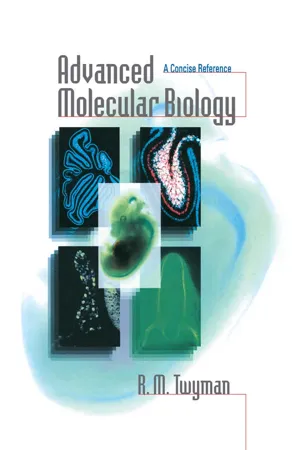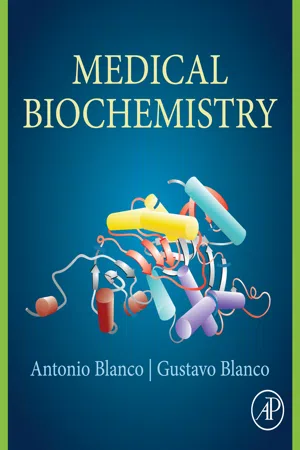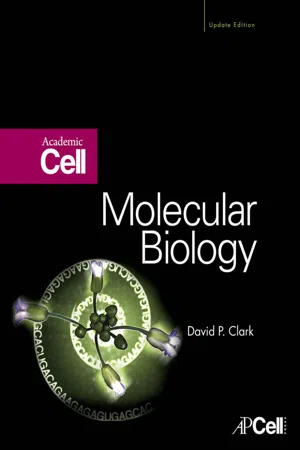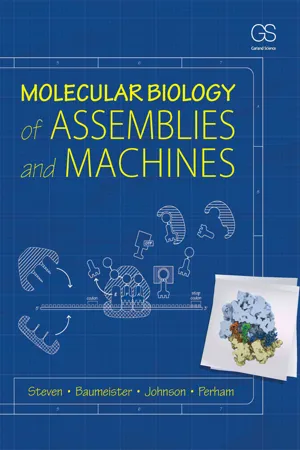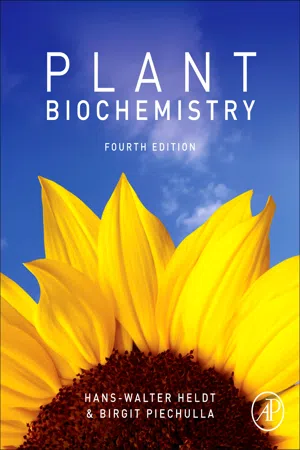Biological Sciences
Protein Synthesis
Protein synthesis is the process by which cells build proteins. It involves two main stages: transcription, where the DNA sequence is copied into messenger RNA (mRNA), and translation, where the mRNA is used as a template to assemble amino acids into a specific protein. This fundamental process is essential for the growth, repair, and maintenance of living organisms.
Written by Perlego with AI-assistance
Related key terms
10 Key excerpts on "Protein Synthesis"
- eBook - ePub
Advanced Molecular Biology
A Concise Reference
- Richard Twyman(Author)
- 2018(Publication Date)
- Garland Science(Publisher)
Chapter 23Protein Synthesis
Fundamental concepts and definitions- Protein Synthesis is the level of gene expression where genetic information carried as a messenger RNA (mRNA) molecule is translated into a polypeptide.
- The components of the Protein Synthesis machinery are mRNA, the template which contains the code to be translated, ribosomes, large ribonucleoprotein particles which are the sites of Protein Synthesis, transfer RNA (tRNA), versatile adaptor molecules which carry amino acids to the ribosome and facilitate the process of translation, and accessory factors associating transiently with the ribosome, required for ribosome assembly and disassembly, and its activity during elongation.
- Like other polymerization reactions, Protein Synthesis has stages of initiation, elongation and termination, each of which may be regulated. The Protein Synthesis mechanism is similar in prokaryotes and eukaryotes, but there are subtle differences in the nature of the components and their order of assembly. There are major differences, however, concerning the context in which Protein Synthesis occurs. In bacteria, transcription and Protein Synthesis occur simultaneously in the cytoplasm (allowing cross-regulation between different levels of gene expression) and mRNA may be polycistronic. In eukaryotes, transcription is confined to the nucleus and the mRNA is exported to the cytoplasm for translation. Nascent mRNA is extensively processed before export and is usually monocistronic (see RNA Processing).
- Following synthesis, a polypeptide undergoes further processing before becoming active. It must fold correctly, a process sometimes requiring the assistance of a molecular chaperone (q.v.). It may be cleaved, and specific residues may be chemically modified or conjugated to small molecules. Such modifications are often associated with the targeting of proteins to specific compartments in the cell or for secretion. Proteins may need to associate noncovalently with other proteins or with nonpolypeptide cofactors for their full activity. For a discussion of these processes, see
- eBook - ePub
- Wiley W. Souba, Douglas W. Wilmore(Authors)
- 2001(Publication Date)
- Academic Press(Publisher)
23 Mechanisms and Regulation of Eukaryotic Protein SynthesisTheresa L. Eisenbraun, Patricia M. Scott, Gregory D. Kennedy, John E. Niederhuber University of Wisconsin Comprehensive Cancer Center, Madison, Wisconsin 53792I. IntroductionII. Overview of Protein SynthesisIII. Methods for Studying Protein SynthesisReferencesI. Introduction
The central dogma of molecular biology is the inheritance of genetic information encoded in specific sequences of nucleic acid known as genes, and the conversion of this encoded information into specific proteins—a concept often referred to as “one gene/one protein.” Inheritance of the information encoded in the nucleic acid sequence occurs by exact replication of the double-stranded DNA. Expression of the information encoded in the nucleic acid sequence involves two sequential processes—transcription and translation. Transcription is the mechanism by which the cell generates a single strand of RNA identical in sequence to one strand of the double-stranded DNA. Translation is the process by which one form of RNA, messenger (mRNA), is used as the template for the synthesis of specific proteins. This chapter focuses on the mechanisms controlling Protein Synthesis and the relevance of the regulation of Protein Synthesis to biomedical research and disease. The chapter also reviews the techniques used to study Protein Synthesis.II. Overview of Protein Synthesis
Until recently, study of the mechanisms controlling gene expression was focused mainly on transcription. Because the majority of eukaryotic mRNAs are monocistronic, i.e., contain only one coding region, regulation of gene expression at the level of translation was not seriously considered. The discovery of mRNAs with 5’ ends that contain more than one possible reading frame, as well as viruses that usurp the host cell translation machinery to preferentially translate their own proteins, provided the first clues that regulation of gene expression could also occur during translation. - eBook - ePub
- Antonio Blanco, Gustavo Blanco(Authors)
- 2017(Publication Date)
- Academic Press(Publisher)
From an evolutionary point of view, the discovery of catalytic RNAs led to the hypothesis that, during evolution, RNA appeared before DNA or proteins; they were needed to perform functions that later were assumed by these molecules. RNA contains information encoded in its base sequence and it duplicates by mechanisms that are similar to those of DNA. Furthermore, RNA forms secondary structures and can adopt various conformations that resemble those of proteins. According to some scholars, sometime during the development of life on Earth (about 4 billion years ago), RNA might have been the fundamental molecule, in what they called the “RNA world.” The later appearance of proteins and DNA offered new molecules that were more suitable for a variety of cell functions. Proteins have the advantage of exhibiting greater chemical and conformational diversity, and are more flexible and efficient as catalysts than RNA. Similarly, DNA has advantages over RNA due to its higher chemical stability. Therefore, evolution and the forces of natural selection might have favored the replacement of RNA for DNA and proteins for activities in which the latter molecules are more advantageous. On the other hand, RNA was conserved for its highly efficient role in translation of the genetic information.Mechanism of protein biosynthesis
Protein biosynthesis comprises the translation of the message contained in mRNA and the assembly of amino acids in the order dictated by mRNA. Three types of RNA (mRNA, ribosomal, and tRNA), as well as a series of proteins participate in this process.Ribosomal particles slide over the mRNA, reading from one codon to the next, and inserting tRNAs one at a time on their respective complementary codon. The amino acids carried by each tRNA are linked by peptidic bonds following the sequence indicated by the mRNA, to form the polypeptide chain. The incorporation of amino acids in the exact sequence requires the correct binding of specific tRNAs to the mRNA guide by codon–anticodon pairing. The mRNA is translated in the 5′→3′ direction and the polypeptide chain is assembled from the N- to the C-terminus.When Protein Synthesis starts, both the major and minor subunits of the ribosome associate with each other, and with the mRNA; the complex disassembles soon after the polypeptide chain synthesis is finished. This process of association and dissociation of the ribosome is called the ribosomal cycle . Each ribosomal particle can simultaneously bind two tRNAs. One is the tRNA loaded with an amino acid (aminoacyl-tRNA), which binds to ribosomal site A; the other, which carries the nascent polypeptide chain in formation (peptidyl-tRNA), binds to ribosomal site P. Finally, the tRNA that has released the finished polypeptide is freed. In prokaryotes this occurs from a third binding site in the ribosome, called the exit site (E).Protein biosynthesis involves four main steps (1) amino acid activation, (2) initiation, (3) elongation, and (4) termination of the polypeptide chain.1. Activation of the amino acids . This stage requires free amino acids, aminoacyl-tRNA synthetases (activating enzymes), tRNA, ATP, and Mg2+ . In a first step, the amino acid reacts with ATP to form an aminoacyl-AMP-enzyme complex. PPi - eBook - ePub
- David P. Clark(Author)
- 2009(Publication Date)
- Academic Cell(Publisher)
3 for a brief overview). The genetic information is transmitted in two stages. First the information in the DNA is transcribed into messenger RNA (mRNA). The next step uses the information carried by the mRNA to give the sequence of amino acids making up a polypeptide chain. This involves converting the nucleic acid “language,” the genetic code, to protein “language,” and is therefore known as translation. This overall flow of information in biological cells from DNA to RNA to protein is known as the central dogma of molecular biology (see Chapter 3, Fig. 3.17) and was first formulated by Sir Francis Crick. Ribosomes use the information carried by messenger RNA to make proteins. The decoding of mRNA is carried out by a submicroscopic machine called a ribosome, which binds the mRNA and translates it. The ribosome moves along the mRNA reading the message and synthesizing a new polypeptide chain. Bacterial Protein Synthesis will be discussed first. The process is similar in higher organisms, but some of the details differ and will be considered later. Proteins Are Gene Products An early rule of molecular biology was Beadle and Tatum’s dictum: “one gene—one enzyme” (see Ch. 1). This rule was later broadened to include other proteins in addition to enzymes. Proteins are therefore often referred to as “gene products.” However, it must be remembered that some RNA molecules (such as tRNA, rRNA, small nuclear RNA) are never translated into protein and are therefore also gene products. Gene products include proteins as well as non-coding RNA Furthermore, instances are now known where one gene may encode multiple proteins (Fig. 8.01). Two relatively widespread cases of this are known—alternative splicing and polyproteins. In eukaryotic cells, the coding sequences of genes are often interrupted by non-coding regions, the introns. These introns are removed by splicing at the level of messenger RNA - eBook - ePub
- Kobus Marais, Kobus Marais(Authors)
- 2022(Publication Date)
- Bloomsbury Academic(Publisher)
The turning point in the development of biology was the discovery of the structure of DNA (Watson and Crick 1953) and the subsequent uncovering of the molecular foundations of heredity (Jacob 1973). These discoveries showed that genes are parts of DNA molecules that encode the sequence of amino acids in all proteins in living cells. Molecular biologists routinely use the language metaphor to explain molecular processes in cells. The synthesis of the mRNA molecule, as a reverse-complementary copy of the genomic DNA sequence of a gene, is called transcription, whereas the Protein Synthesis on a ribosome, guided by the sequence of nucleotides in the mRNA, is called translation. These became technical terms in molecular biology, and were later incorporated in more complex derivative terms. For example, proteins that facilitate or regulate transcription are called transcription factors, and proteins involved in translation are called translation factors.In contrast to human communication, which is mostly interactive, the information transfer in cells is typically unidirectional: from DNA sequence to mRNA sequence and then from mRNA to the order of amino acids in the protein. This concept was first proposed by Francis Crick (1958), who emphasized the fundamental irreversibility of Protein Synthesis (he called it ‘the central dogma’, because of the deficiency of direct evidence). Crick wrote:In more detail, the transfer of information from nucleic acid to nucleic acid, or from nucleic acid to protein may be possible, but transfer from protein to protein, or from protein to nucleic acid is impossible. Information means here the precise determination of sequence, either of bases in the nucleic acid or of amino acid residues in the protein.(1958: 153)Later, it was discovered that some viruses can copy the RNA sequence to DNA using enzyme ‘reverse transcriptase’ – this shows that the central dogma is not universal. However, there are no examples of natural processes that convert a protein sequence to an original nucleotide sequence.The details of information transfer from a gene to the protein, known as gene expression, are as follows. The first step is transcription, which is copying of a DNA sequence into the newly synthesized RNA sequence performed by the RNA polymerase enzyme. Both DNA and RNA are nucleic acids, which are long polymers of nucleotides linked via sugar (desoxyribose or ribose, respectively) and a phosphate. DNA is a double-stranded spiral (helix), where two polymers have matching pairs of nucleotides: A, T, G and C in one strand match to T, A, C and G, respectively, in the other strand. In contrast, RNA is a single-strand polymer synthesized in a template-matching way on one of the DNA strands. In the nucleus of a cell, the RNA polymerase, assisted with one or multiple transcription factors, binds to the starting end of a gene, called promoter. This action is followed by the separation of two DNA strands, and RNA polymerase moves along one of the DNA strands and adds nucleotides to the RNA that match to the DNA nucleotides using the same rule of pairing as in the DNA helix. The only difference is that, instead of the T nucleotide, the RNA uses a similar substitute, U. From the semiotic point of view, biological transcription is a subtype of translation, which is literal and automated, but not deterministic, because it is regulated by a large number of internal and external signals. Transcription of a gene sequence is a goal-directed semiotic process (in contrast to unintended making footprints on a sandy beach), because it presumably emerged as a result of adaptive evolution from other primordial metabolic functions (e.g. RNA-templated RNA synthesis), and it is performed by the RNA polymerase enzyme, an agent that evolved to perform this specific function guided by imprinted goal directedness. - eBook - ePub
- Pascal Leclair(Author)
- 2023(Publication Date)
- CRC Press(Publisher)
8 Protein Synthesis Part II The Mechanism of Protein TranslationDOI: 10.1201/9781003379058-8In 1957, Francis Crick gave what would become a most significant lecture on Protein Synthesis at University College London during a Society for Experimental Biology symposium on the “Biological Replication of Macromolecules”. In the hour-long lecture, which is now referred to as the “Central Dogma” lecture and about which is said to have permanently altered the logic of biology,1 Crick summarized the development in protein research with an emphasis on the mechanism of Protein Synthesis and makes clear that proteins’ role in cells is at least of equal footing as that of DNA:It is an essential feature of my argument that in biology proteins are uniquely important. They are not to be classed with polysaccharides, for example, which by comparison play a very minor role. Their nearest rivals are the nucleic acids. Watson said to me, a few years ago, ‘The most significant thing about the nucleic acids is that we don’t know what they do.’ By contrast the most significant thing about proteins is that they can do almost anything. In animals proteins are used for structural purposes, but this is not their main role, and indeed in plants this job is usually done by polysaccharides. The main function of proteins is to act as enzymes. Almost all chemical reactions in living systems are catalysed by enzymes, and all known enzymes are proteins. It is at first sight paradoxical that it is probably easier for an organism to produce a new protein than to produce a new small molecule, since to produce a new small molecule one or more new proteins will be required in any case to catalyse the reactions. - eBook - ePub
- Alasdair Steven, Wolfgang Baumeister, Louise N. Johnson, Richard N. Perham(Authors)
- 2016(Publication Date)
- Garland Science(Publisher)
6 Protein Synthesis and Folding6.1 Introduction
As outlined in Chapter 1 , the genetic code relates the information stored in DNA codons to the sequence of amino acids in polypeptide chains. The process of translation from one language to the other is mediated by the ribosome, the quintessential machine of Protein Synthesis (Section 6.2). The ribosome is a large particle (2.5–4.2 MDa, depending on origin), built from two subunits, called large (L) and small (S). (Here ‘subunit’ refers to a complex of multiple proteins and RNA molecules rather than, as elsewhere in this book, a single polypeptide chain.) All ribosomes comprise three RNA molecules plus many (50–80) protein subunits. The overall organization is similar in all three kingdoms of life, reflecting ancient evolutionary origins. In sum, the ribosome binds an mRNA molecule and polypeptide synthesis ensues in four stages: initiation, elongation, termination, and recycling. At each stage, additional protein factors associate transiently with the ribosome–mRNA complex.To become functional, a newly synthesized polypeptide chain must fold into a specific three-dimensional conformation. Usually, this ‘native’ conformation corresponds to the global minimum of the free energy landscape (Section 1.3). Folding is governed by thermodynamics, and all the information needed resides in the amino acid sequence. Folding can commence during Protein Synthesis—that is, co-translationally—but cannot be completed before the whole polypeptide chain has been synthesized. With a protein that consists of multiple independently folding domains, N-terminal domains fold before distal regions have been synthesized. Folding may stall in intermediate states and there may be nonproductive interactions with other proteins. To avoid such outcomes, many proteins rely on specialized helper proteins, named chaperones - Tina M. Henkin, Joseph E. Peters(Authors)
- 2020(Publication Date)
- ASM Press(Publisher)
central dogma of molecular biology, which states that information stored in DNA is copied into RNA and then translated into protein. We now know of many exceptions to the central dogma. For example, information can sometimes flow in the reverse direction, from RNA to DNA. The information in RNA also can be changed after it has been copied from the DNA. Moreover, the information in DNA may be expressed differently depending on where it is in the genome. Despite these exceptions, however, the basic principles of the central dogma remain sound.This chapter outlines the process of gene expression and Protein Synthesis, with a brief discussion of how proteins can be differentially localized after synthesis. The discussion is meant to be only a broad overview, with special emphasis on topics essential to an understanding of the chapters that follow and on subjects unique to bacteria. For more detailed treatments, consult any modern biochemistry textbook.Overview
DNA carries the information for the synthesis of RNA and proteins in regions called genes . The first step in expressing a gene is to transcribe an RNA copy from one strand in that region. The word “transcription” is descriptive, because the information in RNA is copied from DNA in the same language, which is written in a sequence of nucleotides. If the gene carries information for a protein, this RNA transcript is called messenger RNA (mRNA) . An mRNA is a messenger because it carries the information encoded in a gene to a ribosome , which is the main machinery for Protein Synthesis. Once on the ribosome, the information in the mRNA can be translated into the protein. Translation is another descriptive word, because one language—a sequence of nucleotides in DNA and RNA—is translated into a different language—a sequence of amino acids in a protein. The mRNA is translated as it moves through the ribosome, 3 nucleotides at a time. Each 3-nucleotide sequence, called a codon , carries information for a specific amino acid. The assignment of each of the possible codons to an amino acid is called the genetic code- eBook - ePub
- Hans-Walter Heldt, Birgit Piechulla(Authors)
- 2010(Publication Date)
- Academic Press(Publisher)
21 Protein biosynthesis occurs in three different locations of a cellDuring protein biosynthesis, the nucleotide sequence of mRNA is translated into an amino acid sequence. The “interpreters” are transfer ribonucleic acids (tRNAs), small RNAs of 75 to 110 ribonucleotides, which have a defined structure with hairpins and loops. One loop exhibits the anticodon , which is complementary to the mRNA codon . For each amino acid there exists at least one and sometimes several tRNAs. The covalent binding of the amino acid to the corresponding tRNA is catalyzed by its specific aminoacyl tRNA synthetase . With the consumption of ATP a mixed anhydride aminoacyl-AMP is synthesized as an intermediate prior to the binding of the amino acid to the 3′ OH of the tRNA (Fig. 21.1 ).Figure 21.1 tRNA is loaded by aminoacyl-tRNA synthetase with its corresponding amino acid, ATP is used for activation and aminoacyl-AMP is formed as an intermediate.In a plant cell, protein biosynthesis takes place in three different locations. The translation of the nuclear encoded mRNAs proceeds in the cytosol, and that of the mRNAs encoded in the plastidic or mitochondrial genome takes place in the plastid stroma and mitochondrial matrix, respectively.21.1 Protein Synthesis is catalyzed by ribosomesRibosomes are large riboprotein complexes that consist of three to four different rRNA molecules and a large number of proteins. In the intervals between the end of the translation of one mRNA and the start of the translation of another mRNA, the ribosomes dissociate into two subunits. The ribosomes of the cytosol, plastids, and mitochondria are different in size and composition (Table 21.1 ). The cytosolic ribosomes (termed eukaryotic ribosomes ), with a sedimentation constant of 80S, dissociate into a small subunit of 40S and a large subunit of 60S. In contrast, the mitochondrial ribosomes , with a size of about 78S, varying from species to species, and the plastidic ribosomes (70S) are smaller. Due to their relationship to the bacterial ribosomes, the mitochondrial and plastidic ribosomes are classified as prokaryotic ribosomes . Ribosomes of the bacteria, e.g., Escherichia coli - eBook - ePub
Amino Acids
Biochemistry and Nutrition
- Guoyao Wu(Author)
- 2021(Publication Date)
- CRC Press(Publisher)
8.10 (Deng et al. 2009 ; McNurlan and Garlick 1980 ; McNurlan et al. 1979 ). Note that the fractional rate of Protein Synthesis in the liver of young rats is about 100%/day, meaning that hepatic proteins are almost completely synthesized de novo every 24 h. In adults who do not usually accrete proteins and have lower rates of Protein Synthesis than the young, Protein Synthesis remains necessary to maintain protein homeostasis in cells (Waterlow 1984 ). In all animals, proteins synthesized and exported by cells, such as hepatocytes, enterocytes, and immunocytes, regulate the concentrations of these proteins in the plasma and other extracellular fluids (Bröer and Bröer 2017 ). For extracellular proteins, the rates of their release from cells are also controlled by exocytosis. The following equation regarding intracellular protein balance applies to all cell types. There could be a positive or negative protein balance in a given tissue or the whole body.Intracellular protein balance = Rate of Protein Synthesis – Rate of protein degradationRegulation of protein metabolism is the biochemical basis for increasing protein deposition in animal tissues, particularly in skeletal muscle, and for decreasing protein wasting in disease conditions and catabolic states (McAllister et al. 2000 ; Waterlow 1984 ). Studies with young pigs by T.A. Davis, P.J. Reeds, and colleagues have shown that an increase in protein accretion in skeletal muscle brought about by protein feeding and AA supplementation results primarily from an increase in Protein Synthesis rather than a decrease in protein degradation (Davis et al. 1998 ; 2002 , 2008 ). Changes in the rates of Protein Synthesis and degradation are also crucial for regulating concentrations of key enzymes in metabolic pathways (see Chapter 10
Index pages curate the most relevant extracts from our library of academic textbooks. They’ve been created using an in-house natural language model (NLM), each adding context and meaning to key research topics.
